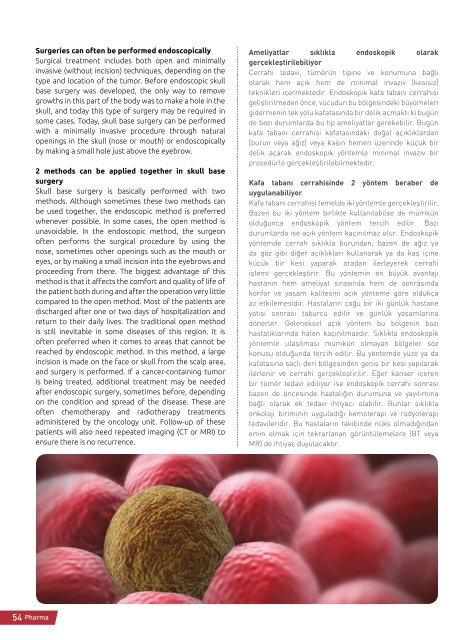Create successful ePaper yourself
Turn your PDF publications into a flip-book with our unique Google optimized e-Paper software.
Surgeries can often be performed endoscopically<br />
Surgical treatment includes both open and minimally<br />
invasive (without incision) techniques, depending on the<br />
type and location of the tumor. Before endoscopic skull<br />
base surgery was developed, the only way to remove<br />
growths in this part of the body was to make a hole in the<br />
skull, and today this type of surgery may be required in<br />
some cases. Today, skull base surgery can be performed<br />
with a minimally invasive procedure through natural<br />
openings in the skull (nose or mouth) or endoscopically<br />
by making a small hole just above the eyebrow.<br />
2 methods can be applied together in skull base<br />
surgery<br />
Skull base surgery is basically performed with two<br />
methods. Although sometimes these two methods can<br />
be used together, the endoscopic method is preferred<br />
whenever possible. In some cases, the open method is<br />
unavoidable. In the endoscopic method, the surgeon<br />
often performs the surgical procedure by using the<br />
nose, sometimes other openings such as the mouth or<br />
eyes, or by making a small incision into the eyebrows and<br />
proceeding from there. The biggest advantage of this<br />
method is that it affects the comfort and quality of life of<br />
the patient both during and after the operation very little<br />
compared to the open method. Most of the patients are<br />
discharged after one or two days of hospitalization and<br />
return to their daily lives. The traditional open method<br />
is still inevitable in some diseases of this region. It is<br />
often preferred when it comes to areas that cannot be<br />
reached by endoscopic method. In this method, a large<br />
incision is made on the face or skull from the scalp area,<br />
and surgery is performed. If a cancer-containing tumor<br />
is being treated, additional treatment may be needed<br />
after endoscopic surgery, sometimes before, depending<br />
on the condition and spread of the disease. These are<br />
often chemotherapy and radiotherapy treatments<br />
administered by the oncology unit. Follow-up of these<br />
patients will also need repeated imaging (CT or MRI) to<br />
ensure there is no recurrence.<br />
Ameliyatlar sıklıkla endoskopik olarak<br />
gerçekleştirilebiliyor<br />
Cerrahi tedavi, tümörün tipine ve konumuna bağlı<br />
olarak hem açık hem de minimal invaziv (kesisiz)<br />
teknikleri içermektedir. Endoskopik kafa tabanı cerrahisi<br />
geliştirilmeden önce, vücudun bu bölgesindeki büyümeleri<br />
gidermenin tek yolu kafatasında bir delik açmaktı ki bugün<br />
de bazı durumlarda bu tip ameliyatlar gerekebilir. Bugün<br />
kafa tabanı cerrahisi kafatasındaki doğal açıklıklardan<br />
(burun veya ağız) veya kaşın hemen üzerinde küçük bir<br />
delik açarak endoskopik yöntemle minimal invaziv bir<br />
prosedürle gerçekleştirilebilmektedir.<br />
Kafa tabanı cerrahisinde 2 yöntem beraber de<br />
uygulanabiliyor<br />
Kafa tabanı cerrahisi temelde iki yöntemle gerçekleştirilir.<br />
Bazen bu iki yöntem birlikte kullanılabilse de mümkün<br />
olduğunca endoskopik yöntem tercih edilir. Bazı<br />
durumlarda ise açık yöntem kaçınılmaz olur. Endoskopik<br />
yöntemde cerrah sıklıkla burundan, bazen de ağız ya<br />
da göz gibi diğer açıklıkları kullanarak ya da kaş içine<br />
küçük bir kesi yaparak oradan ilerleyerek cerrahi<br />
işlemi gerçekleştirir. Bu yöntemin en büyük avantajı<br />
hastanın hem ameliyat sırasında hem de sonrasında<br />
konfor ve yaşam kalitesini açık yönteme göre oldukça<br />
az etkilemesidir. Hastaların çoğu bir iki günlük hastane<br />
yatışı sonrası taburcu edilir ve günlük yaşamlarına<br />
dönerler. Geleneksel açık yöntem bu bölgenin bazı<br />
hastalıklarında halen kaçınılmazdır. Sıklıkla endoskopik<br />
yöntemle ulaşılması mümkün olmayan bölgeler söz<br />
konusu olduğunda tercih edilir. Bu yöntemde yüze ya da<br />
kafatasına saçlı deri bölgesinden geniş bir kesi yapılarak<br />
ilerlenir ve cerrahi gerçekleştirilir. Eğer kanser içeren<br />
bir tümör tedavi ediliyor ise endoskopik cerrahi sonrası<br />
bazen de öncesinde hastalığın durumuna ve yayılımına<br />
bağlı olarak ek tedavi ihtiyacı olabilir. Bunlar sıklıkla<br />
onkoloji biriminin uyguladığı kemoterapi ve radyoterapi<br />
tedavileridir. Bu hastaların takibinde nüks olmadığından<br />
emin olmak için tekrarlanan görüntülemelere (BT veya<br />
MR) de ihtiyaç duyulacaktır.<br />
54 <strong>Pharma</strong>

















